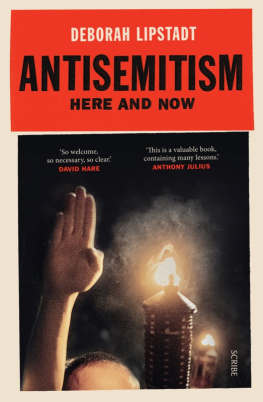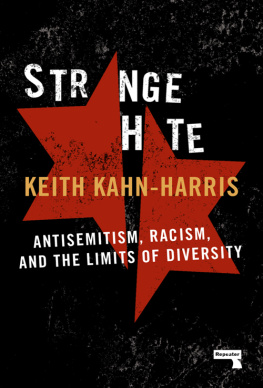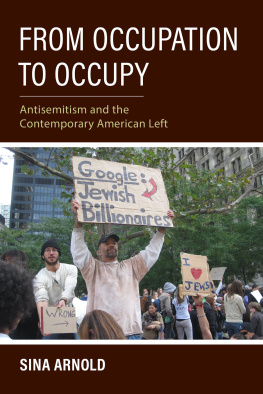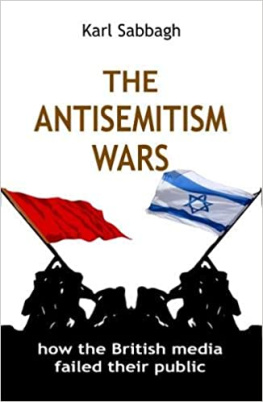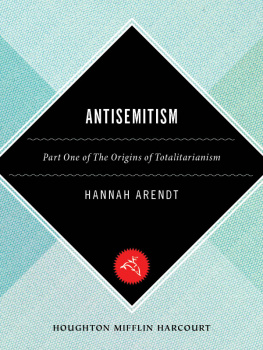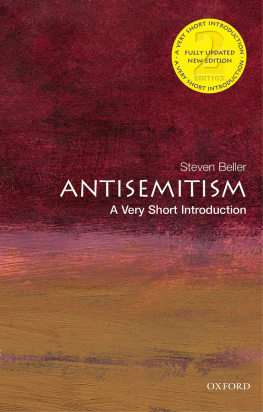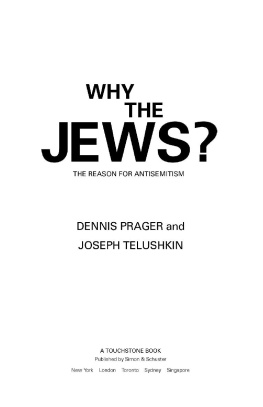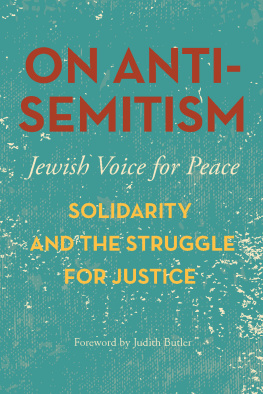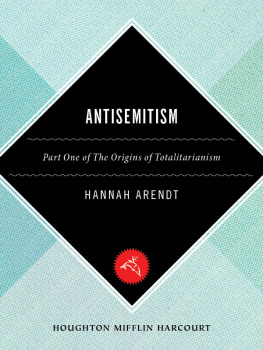
ANTISEMITISM
Deborah Lipstadt is Dorot Professor of Modern Jewish History and Holocaust Studies at Emory University. Her books include The Eichmann Trial , Denial: holocaust history on trial (a National Jewish Book Award-winner), Denying the Holocaust: the growing assault on truth and memory , and B eyond Belief: the American press and the coming of the Holocaust , 19331945. She lives in Atlanta.
Scribe Publications
1820 Edward St, Brunswick, Victoria 3056, Australia
2 John St, Clerkenwell, London, WC1N 2ES, United Kingdom
First published by Scribe 2019
Copyright Deborah Lipstadt 2019
All rights reserved. Without limiting the rights under copyright reserved above, no part of this publication may be reproduced, stored in or introduced into a retrieval system, or transmitted, in any form or by any means (electronic, mechanical, photocopying, recording or otherwise) without the prior written permission of the publishers of this book.
The moral rights of the author have been asserted.
9781925322675 (Australian edition)
9781925228670 (UK edition)
9781925307580 (e-book)
CiP records for this title are available from the National Library of Australia and British Library.
scribepublications.com.au
scribepublications.co.uk
To the memory of my mother, Miriam bat Natanel and Rebecca.
God was her refuge and her fortress (Psalm ).
She was my greatest fan.
CONTENTS
I. ANTISEMITISM: A CONVERSATION
II. A TAXONOMY OF THE ANTISEMITE
III. CONTEXTUALIZING ANTISEMITISM
IV. YES, BUT: RATIONALIZING EVIL
V. HOLOCAUST DENIAL: FROM HARD-CORE TO SOFT-CORE
VI. THE CAMPUS AND BEYOND
VII. OY VERSUS JOY: REJECTING VICTIMHOOD
A NOTE TO THE READER
This has been a challenging project. I was surprised by the difficulties I encountered in writing this book, for it was hardly my first foray into addressing painful topics. I have been writing, teaching, and speaking about the Shoah, one of the most all-encompassing examples of state-sponsored genocide, for decades. Given that I have already spent so much of my scholarly and personal time skulking in the sewers of antisemitism and genocide, why should this project have been any different from the many others that preceded it? The answer became clear as I wrote. As horrific as the Holocaust was, it is firmly in the past. When I write about it, I am writing about what was. Though I remain horrified by what happened, it is history. Contemporary antisemitism is not. It is about the present. It is what many people are doing, saying, and facing now. That gave this subject an immediacy that no historical act possesses.
But it is not just about the present. It is also about the future. Where are the troubling phenomena addressed here leading? And that question points to yet another difficulty. Most historians avoid speculating about the future. We eschew predictions because we know how quickly things can change. Often, those historians who have relied on their knowledge of the past to prognosticate have erred. And yet, when one writes about a contemporary problem, it is hard not to predict. Aware of this, I try very hard in this book to avoid doing so. After addressing some basics of the issuedefining antisemitism, categorizing the antisemite, and figuring out how best to spell the wordI try to unpack what it is we are witnessing. Is todays antisemitism the same or different from what we have seen before? Where is it coming from: the right or the left? Is it, as some would contend, all about Israel? Are we seeing antisemitism where it is not? Are others refusing to see antisemitism where it clearly is?
While there seems to have been a decided increase in both physical acts and rhetorical expressions of antisemitism in recent years, our conversation should not be rooted in or motivated by numbers or by antisemitic acts. This would suggest that, if the numbers decrease, our worries should abate. I remember that during the 2000 American presidential campaign many Jews predicted that Al Gores selection of Joseph Lieberman as his running mate would precipitate a rise in antisemitism. It didnt happen. Some pundits then opined that perhaps antisemitism was dead. They looked at the American social landscape and saw Jewish presidents presiding over universities that once had strict quotas. They saw Jews sitting on the boards of major corporations and being elected to public office from regions without a significant Jewish population. Even the skyrocketing rate of intermarriage, a source of angst within the Jewish community, could be spun into something positive. If so many non-Jews are so willing to have Jews in their families, how prevalent could antisemitism be? But today, antisemitism is back. (I am not sure it ever really went away.) An accurate accounting of the uptick in antisemitic incidents is important because it does provide necessary empirical evidence. Nonetheless, numbers should not be what drive us. What should alarm us is that human beings continue to believe in a conspiracy that demonizes Jews and sees them as responsible for evil. Antisemites continue to give life to this particular brand of age-old hatred. They justify it and the acts committed in its name. The historical consequences of this nefarious passion have been so disastrous that to ignore its contemporary manifestations would be irresponsible.
Another reason numbers should not drive us is that antisemitism is a worldview, a conspiracy theory. It therefore cannot simply be measured by the number of recorded antisemitic acts or by the number of people being categorized as antisemites. A recent study in Great Britain called the approach I have taken the elastic view of antisemitism. If Jew-hatred is an attitude, it exists, like all attitudes, in society at different levels of intensity, and with different shades to it.... Some people may be strongly antisemitic, others less so; and while still others may not fit into either of these categories, they may still hold certain [antisemitic] attitudeseven if these are small in number and weak in intensity.
Since antisemitism affects Jews, some readers may be inclined to think that only Jews should be concerned. That would be a mistake. Jews, as the intended target of the antisemite, may indeed be more sensitive to it. Such is the case with any expression of particular hatred and prejudice. But the existence of prejudice in any of its forms is a threat to all those who value an inclusive, democratic, and multicultural society. It is axiomatic that if Jews are being targeted with hateful rhetoric and prejudice, other minorities should not feel immune; this is not likely to end with Jews. And, conversely, if other minority groups are being targeted with hatred and prejudice, Jews should not feel immune; this is not likely to end with these groups, either. Antisemitism flourishes in a society that is intolerant of others, be they immigrants or racial and religious minorities. When expressions of contempt for one group become normative, it is virtually inevitable that similar hatred will be directed at other groups. Like a fire set by an arsonist, passionate hatred and conspiratorial worldviews reach well beyond their intended target. They are not rationally contained. But even if the antisemites were to confine their venom to Jews, the existence of Jew-hatred within a society is an indication that something about the entire society is amiss. No healthy society harbors extensive antisemitismor any other form of hatred.
I have organized this book as a series of letters to two fictional people with whom I have become acquainted at the university at which I teach. One is Abigail, a whip-smart Jewish student who has taken many of my courses and who is trying to understand the phenomenon of antisemitism. The other is Joe, a colleague who teaches at the universitys law school. A non-Jew, he has a deep appreciation for both the successes and travails of the Jewish people, and he counts some of his Jewish colleagues as his most important conversation partners on campus. Abigail and Joe are composites of many people who have turned to me during the past few years to express their confusion, worries, and distress about antisemitism in general and about what they are personally witnessing. They may be fictional figures, but the questions they ask and the concerns they express belong to very real people. I have structured the letters to reflect the situation as of summer 2018 .
Next page
